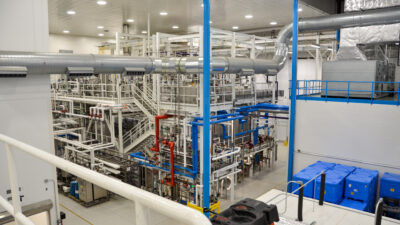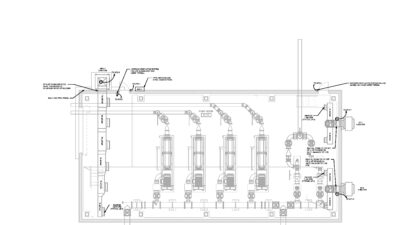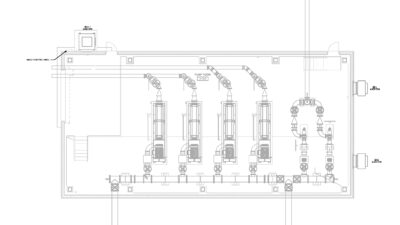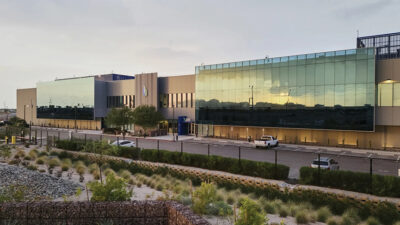The need for a fire pump should be decided early—ideally as a project scope is being developed. This article outlines a process to determine if a fire pump is needed and explains how to select a fire pump that meets the required pressure and flow.

A fire pump is needed to supply the flow and pressure demands to fire suppression systems when there is an inadequate water supply. The need for a fire pump should be decided early—ideally as a project scope is being developed. This article will outline a process to determine if a fire pump is needed and explains how to select a fire pump that meets the required pressure and flow.
To determine if a fire pump is needed, the fire suppression system demands must be compared with the available water supply. If the supply cannot meet the demand, a fire pump is required. Conversely, if the water supply can meet the pressure and flow requirements, a fire pump is not needed.
Water can be supplied from a variety of different sources including public water mains, dedicated fire protection fire mains, elevated tanks, etc. Each scenario requires a slightly different approach, but first, it is important to determine if the water supply can accommodate the flow demands. For simplicity, this article assumes that the water supply contains an adequate volume to meet flow and duration needs.
When connecting to a fire main, hydrant-flow tests can be used to analyze the supply. Static and residual pressures as well as flow rate data help to conclude if the supply system can flow the amount of water needed and determine what residual pressure is available. It is most helpful to get this test data as close to the fire suppression system riser as possible to decrease errors resulting from hydraulic-calculation estimates.
When determining the worst-case flow, consider the flow demands from all of the fire suppression systems. For this example, the worst-case flow demand is an automatic sprinkler system in an office building. It is assumed that standpipe demand would be supplied via a firefighting apparatus.
Sprinkler demands are calculated per NFPA 13 based on factors such as design area, density, hose steam, overages, roof slope, and dry/pre-action system.
- Example: a light-hazard 5-story office building
- Sprinkler: 0.1 gpm/ft2 x 1500 ft2 = 150 gpm
- Sprinkler + 30% overage: 150 x 1.3 = 195 gpm
- Hose: 100 gpm
- Total: 295 gpm
The calculation shows a flow demand of 295 gpm. If the connected fire main cannot supply this flow, then a water tank and pump will need to be provided to flow the required amount to the sprinkler system. With the flow requirements known, the next step is to calculate the pressure required to operate the sprinkler system.
The pressure required to meet the system demand is calculated by first considering the pressure required at the most remote sprinkler and then adding all of the various pressure losses back to the supply. The minimum pressure required at a sprinkler head is defined per NFPA 13 and is typically 7 psi. Use a greater value to be conservative. Working back toward the supply, the sprinkler system pressure can be estimated to be ~20 psi. This is a decent guideline when supplying simple sprinkler systems. As sprinkler piping becomes more complicated due to strange floor layouts, obstructions, and uneven ceiling heights, increase the estimate accordingly.
Friction losses through the pipe from the sprinkler riser to the water supply can be estimated using the Hazen-Williams formula defined in NFPA 13. Pipe sizes; pipe lengths; fittings and their equivalent length of pipe; and C-factors can all be estimated to calculate a conservative pressure loss from friction. Hazen-Williams calculates a friction loss per foot, that value can then be multiplied by the total length of pipe to determine the pressure lost. Elevation is an important factor to pressure losses because overcoming gravity requires a significant amount of pressure: 0.433 psi is lost per foot of elevation needed to overcome. Major appurtenances, such as backflow preventers and strainers, should also be considered since pressure is lost as water flows through these devices. Product datasheets can be used to estimate the pressure lost through these pipe appurtenances.
Below is an example of the calculation showing the supply pressure required:
- Remote sprinkler: 10 psi
- Sprinkler system pressure loss: 20 psi
- Friction losses from supply to sprinkler system riser: 10 psi
- Elevation: 21 psi
- Backflow preventer: 7 psi
- Safety factor: 10 psi
- Total pressure required: 78 psi
At this point, the flow requirement and required pressure has been calculated and must be compared with the flow capacity and pressure available.
In this example, it is assumed the sprinkler system is connected to a city water main, and the hydrant-flow test data shows 65-psi static and 40-psi residual while flowing 500 gpm. This data shows that the water supply can adequately meet the flow requirements, but the available pressure does not meet the required pressure. Therefore, a fire pump is required to boost the pressure by 38 psi while meeting the required flow rate.
Fire pumps need to be selected based on their rated flow and pressure capacity. In our example, the required flow is 295 gpm. Fire pumps are required to operate at 150% of their rated flow. Therefore, it is not required to select a pump rated at the flow demand; this would result in an oversized pump. For instance, if the flow demand is 295 gpm, a 200-gpm-rated fire pump can technically supply that flow. The design point is just under 150% of its rated curve. Typically, using a design point between 115% and 135% of rated flow is preferred. In this example, a 250-gpm pump should be selected. Designing too close to the 150% curve may be problematic, with unseen issues or alterations over the life of the system. Specific pump curves should be analyzed for peak efficiency.
Knowing that the pump needs to provide a 38-psi pressure boost, it is time to research available pump curves with at least a 38-psi-rated total head. The total rated head is the pressure boost supplied at the rated flow.
Many fire pump manufacturers provide selection tools on their websites where the required flow and pressure can be input, and their results show the pumps offered that can meet those requirements. NFPA provides limits on the performance of pumps. This ensures that pump curves are not too steep, which would allow the pressure boost to drop quickly. At 150% of a pump’s rated capacity, it can provide no less than 65% of its rated total head.
As pumps flow at rates beyond their rated flow, the pressure they can provide decreases. Some pumps have flatter curves where the pressure drops slowly as the flow increase, and others lose pressure more quickly. It is important to consider where on the pump curve the flow requirement is located. At the water-flow demand point, the pressure boost provided by the pump needs to be greater than the pressure required.
For a final check, place the design point (required flow and pressure) on the manufacturer’s pump curve. This point needs to be below the pump curve to ensure that the pump will meet the needs of the suppression system.
There are likely many pumps offered that meet the performance requirements, but having the pressure and flow requirements will allow the design to progress and help scope the general size, cost, and space needed for the installation. Many other options, styles, and arrangements of fire pumps exist and will work, but the fact remains that each must meet the performance required by the suppression systems.
How to determine if a fire pump is needed:
- Gather fire water-supply information
- Calculate required flow
- Calculate required pressure
- If supply cannot meet flow, provide fire water tank and fire pump
- If pressure cannot be met, provide fire pump
- If supply can meet required pressure and flow, no fire water tank or fire pump is needed
How to select a fire pump:
- Gather fire water-supply information
- Calculate required flow
- Calculate required pressure
- Calculate pressure boost required
- Select pump where flow demand is between 100% and 150% of rated flow. Preferably between 115% and 135%.
- Select pump with performance curve where pressure boost is sufficient at flow demand.
Robert Kranz, a fire protection engineer with Page, has fire protection experience in corporate loss control as both a government-contractor owner-user and as a design consultant. With nearly a decade of experience, Kranz has been responsible for performing life safety analyses, maintaining and modifying existing fire protection systems, creating fire protection design documents, and using fire-modeling software to evaluate unique property and life safety risks. Page is a CFE Media content partner.



